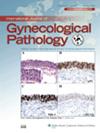Confusing Histopathological Features and HPV Testing Results in Vulvar Squamous Cell Carcinoma Arising in a Young Woman: A Case Solved Using Next-Generation Sequencing
IF 1.6
4区 医学
Q3 OBSTETRICS & GYNECOLOGY
International Journal of Gynecological Pathology
Pub Date : 2024-07-24
DOI:10.1097/pgp.0000000000001047
引用次数: 0
Abstract
Vulvar squamous cell carcinoma (VSCC) can be classified according to human papillomavirus (HPV) status as HPV-associated (HPV-A) and HPV-independent (HPV-I). However, a small subset of tumors may show overlapping features and become a serious diagnostic challenge for pathologists. We report an unusual case of VSCC arising in a 21-year-old patient with type 1 diabetes mellitus. The tumor had keratinizing histologic features, was associated with a premalignant lesion with features of a high-grade squamous intraepithelial lesion (HSIL), and showed consistent p53 immunohistochemical (IHC) overexpression, but variable results in the HPV testing and p16 IHC staining. Molecular analysis revealed mutation of TP53 and overexpression of cell cycle-regulating genes (including CCND1) and collagen-coding genes (such as COL6A1). These molecular findings in genes, previously reported as upregulated in HPV-I VSCC, supported an etiological origin independent of HPV for the tumor. In conclusion, molecular analysis may help to correctly classify challenging VSCC, showing puzzling clinical, morphologic, and IHC characteristics.一名年轻女性外阴鳞状细胞癌的组织病理学特征和 HPV 检测结果令人困惑:利用新一代测序技术解决的一个病例
外阴鳞状细胞癌(VSCC)可根据人乳头状瘤病毒(HPV)状态分为HPV相关型(HPV-A)和HPV无关型(HPV-I)。然而,一小部分肿瘤可能会表现出重叠的特征,这对病理学家来说是一个严峻的诊断挑战。我们报告了一例不寻常的 VSCC 病例,患者 21 岁,患有 1 型糖尿病。该肿瘤具有角化组织学特征,与具有高级别鳞状上皮内病变(HSIL)特征的恶性前病变相关联,并显示出一致的p53免疫组化(IHC)过表达,但HPV检测和p16 IHC染色结果不一。分子分析显示 TP53 发生了突变,细胞周期调节基因(包括 CCND1)和胶原编码基因(如 COL6A1)过度表达。以前曾有报道称,这些基因在 HPV-I VSCC 中上调,这些分子研究结果支持该肿瘤的病因与 HPV 无关。总之,分子分析有助于对临床、形态和 IHC 特征令人费解的 VSCC 进行正确分类。
本文章由计算机程序翻译,如有差异,请以英文原文为准。
求助全文
约1分钟内获得全文
求助全文
来源期刊
CiteScore
3.90
自引率
12.50%
发文量
154
审稿时长
6-12 weeks
期刊介绍:
International Journal of Gynecological Pathology is the official journal of the International Society of Gynecological Pathologists (ISGyP), and provides complete and timely coverage of advances in the understanding and management of gynecological disease. Emphasis is placed on investigations in the field of anatomic pathology. Articles devoted to experimental or animal pathology clearly relevant to an understanding of human disease are published, as are pathological and clinicopathological studies and individual case reports that offer new insights.

 求助内容:
求助内容: 应助结果提醒方式:
应助结果提醒方式:


